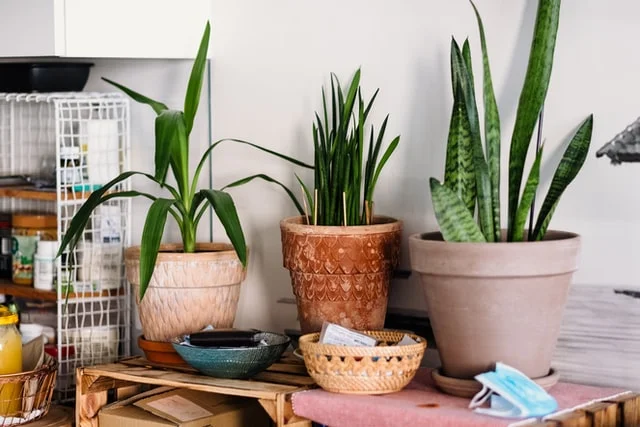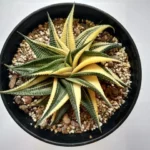Table of Contents
How To Care For Sansevieria Zeylanica
Are you looking for a plant with a bit of height to it? If you don’t have a lot of space, the Sansevieria Zeylanica could be the ideal plant for you.
Not only will it fit snugly on your desk, but it also looks incredible. Its leaves are mostly green, but then done have some tiger patterns with a lighter shade of green. It’s the kind of plant that says you know about plants, even if you don’t.
Today, I want to share with you my advice on taking care of the Sansevieria Zeylanica.
What does your Sansevieria Zeylanica require?
The Sansevieria Zeylanica is a popular houseplant. Therefore, it won’t be super hard to take care of- millions of other people have done it before you.
However, you may want to follow our advice if you want the leaves to be as stunning and vibrant as it could be.
If this is your first houseplant or you work long hours, Sansevieria Zeylanica could be perfect for you.
Light Requirements
The best type of light for Sansevieria Zeylanica will be medium light. This is what it’s used to in its natural habitat.
However, if you are only providing it with either low or high light, the colours might not be as bright, but it will still survive and look lovely on your desk.
Make sure to keep it out of the direct hot sun as it can easily burn.
Temperature Requirements
The great thing about Sansevieria Zeylanica is that it doesn’t really have any specific temperature requirements. So long as you’re comfortable, the plant will be too.
Just be sure to keep it out of any room with a cold draught, and don’t put it next to heating or air-con units. And the Sansevieria Zeylanica is best kept indoors as it won’t tolerate frost or snow.
But it’s not like other plants that have particular temperature zones they need to stay in.
Soil Requirements
Make sure the soil is well-draining. If too much water is sitting around the roots, they will not absorb all of it, which can quickly lead to root rot.
The best type of soil for Sansevieria Zeylanica is actually a combination of two soils. Most garden centres will have a “succulent and cactus mix” and generic “potting soil” Mix these in a ratio of 1:1. You will have the perfect soil for Sansevieria Zeylanica.
For extra drainage, try adding some pummel stones into the soil.
Humidity Requirements
Some plants need humidity to survive. Other plants will die if there’s water in the air. Sansevieria Zeylanica is neither of them.
Whether the room is dry or humid, Sansevieria Zeylanica will be absolutely fine! This makes it just as good as a desk buddy as it is as a bathroom buddy.
You don’t need to worry about the leaves not getting enough moisture. Still, you also don’t need to worry about the humidity making the leaves rot.
How to Water
As with every other houseplant, you do need to be careful not to overwater it. Too much water and the roots will stop absorbing it.
With a load of water just hanging about by the roots, the plant is far more likely to develop root rot.
Make sure the soil is dry before you give it it’s next water. Most people will water their Sansevieria Zeylanica every 2 to 8 weeks.
How often you provide it with water will depend on the environment, type of soil, pot size, and other factors.
How to Fertilize
Fertilizing a plant is when you add nutrients to the soil. It helps keep your plants healthy and speeds up their growth. In the wild, plants get fertilized when other plants die and leak their nutrients into the ground.
With pot plants, they need a bit of a helping hand.
Any generic houseplant fertilizer will be adequate for Sansevieria Zeylanica. And make sure when the summer and spring come around, you’re not fertilizing it more than twice a month.
Make sure you don’t give it any fertilizer when it’s stressed. This could mean when it has too much or not enough water. Basically, make sure the plant is alive before you make it thrive!
Extra tips for Sansevieria Zeylanica
As you can see, looking after Sansevieria Zeylanica is not very difficult at all. I’m sure almost all of our readers will be able to do it.
The following tips are for people who want to be the talk of the town when it comes to how well you’re looking after your plants.
These might be useless for some of you, but hopefully, at least a few of you will find them useful.
Pests & Diseases
Generally, Sansevieria Zeylanica is very resistant to pests and diseases. However, if you notice any mould, be sure to spray it with fungicide.
And if you notice mealybugs or spider mites, give it a spray with some insecticide.
Pruning
The only pruning you will need to do to your Sansevieria Zeylanica is to cut off the rotten leaves.
The best time to do this is during the spring and summer, when the leaves can regrow best. But if a leaf is super rotten, just cut it off straight away.
No matter what time of year you’re cutting away the rotten leaves, make sure to do it with sharp, clean tools so the plant doesn’t become infected.
Propagation
The Propagate the Sansevieria Zeylanica, the first step is to cut off a leaf. Then wait for 24 hours for the leaf to dry.
Once it’s dry, place the end of the leaf into a small pot of water for 3-4 weeks for the roots to start sprouting.
Once you notice the roots, it’ll be time to move it to a larger pot- with the 1:1 soil! As the plant grows, you will need to move it to a larger pot.
When the plant is finished, you can either have more than one Sansevieria Zeylanica or give some away to your friends.
FAQ
Is Sansevieria Zeylanica a snake plant?
Yes, Sansevieria Zeylanica is a snake plant. It has leaves that resemble a snake’s scales.
Snake plants are a trendy type of houseplant because of how easy they are to look after!
There are over 30 different types of snake plant out there! Some of them, such as Sansevieria Zeylanica, make better houseplants than others.
Height and growth rate
The Sansevieria Zeylanica will generally grow between 75-100m high. But you need to remember, Sansevieria Zeylanica is a very slow-growing plant, so don’t expect it to go from baby plant to adult overnight.
In the wild, it will probably be much taller than it will be in your home. But this doesn’t mean it won’t look fantastic in your home!
Is Sansevieria Zeylanica toxic?
Sansevieria Zeylanica are toxic! For both humans and animals. But thankfully, it’s only dangerous if you eat it!
The toxicity is hidden within the tough leaves, so you won’t need to worry about it just being in the room! Our advice would simply be not to eat it!
If you’re looking to grow food in the home, Sansevieria Zeylanica is not the best plant.
Origin of Sansevieria Zeylanica
Sansevieria Zeylanica is a tropical plant, most commonly found naturally in the western parts of Africa.
Here, the climate is naturally both warm and humid. But the great thing about Sansevieria Zeylanica is how easily it can adapt to new environments.
Does Sansevieria Zeylanica have rhizomes?
Yes, Sansevieria Zeylanica do have rhizomes. Most plants do!
The rhizome is simply a stem that grows underground. You need to be careful not to let too much water sit around this as it can cause root rot.
You can even use the rhizome for propagation!
What is Sansevieria Zeylanica good for?
Sansevieria Zeylanica is the ideal plant for any room in the house. It will give an extra spark of colour and nature to even the dullest of rooms. But there’s more to it than that!
Sansevieria Zeylanica is also an excellent air purifier. It will absorb all sorts of toxins, including formaldehyde and carbon dioxide.
This makes it the perfect bedroom plant. When you sleep in a room with Sansevieria Zeylanica, you can rest easy knowing the air you’re breathing is clean and healthy.
Does Sansevieria Zeylanica need sun?
Yes, Sansevieria Zeylanica does need sun. All plants need sun. Sunlight is their version of food!
Like with most houseplants, Sansevieria Zeylanica thrives best when the sunlight is bright but indirect.
Does Sansevieria Zeylanica help you sleep?
Yes, Sansevieria Zeylanica does help you sleep. Not only will it provide you with more oxygen, but it will also remove some of the more harmful chemicals that may be lurking about in the air.
The result of this is that your body can breathe easier, and you won’t be waking up in the middle of the night to try and get some of that much-needed oxygen.
Does Sansevieria Zeylanica attract bugs?
Of course, all plants could attract bugs. But thankfully, Sansevieria Zeylanica doesn’t usually.
The leaves are incredibly thick, and being able to penetrate them is not something that all bugs can do because their teeth are too small!
But of course, it’s always wise to keep on eye out, just in case some of our tiny friends do decide to make a buffet out of your Sansevieria Zeylanica.
Photo by freestocks on Unsplash



